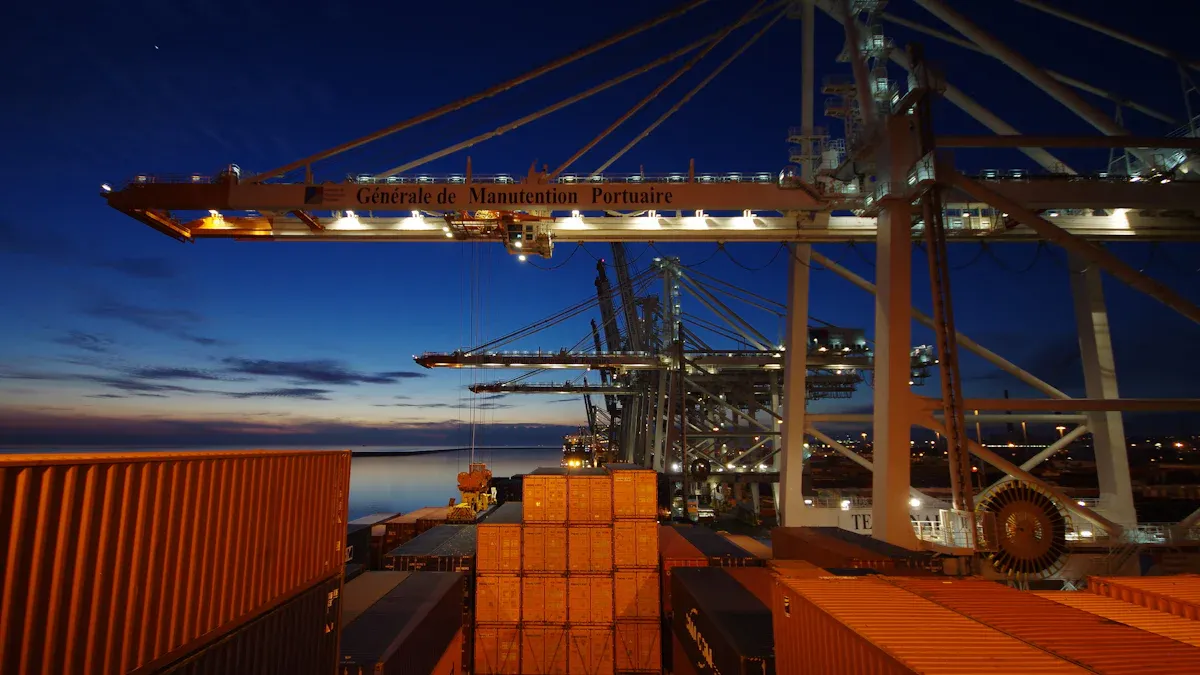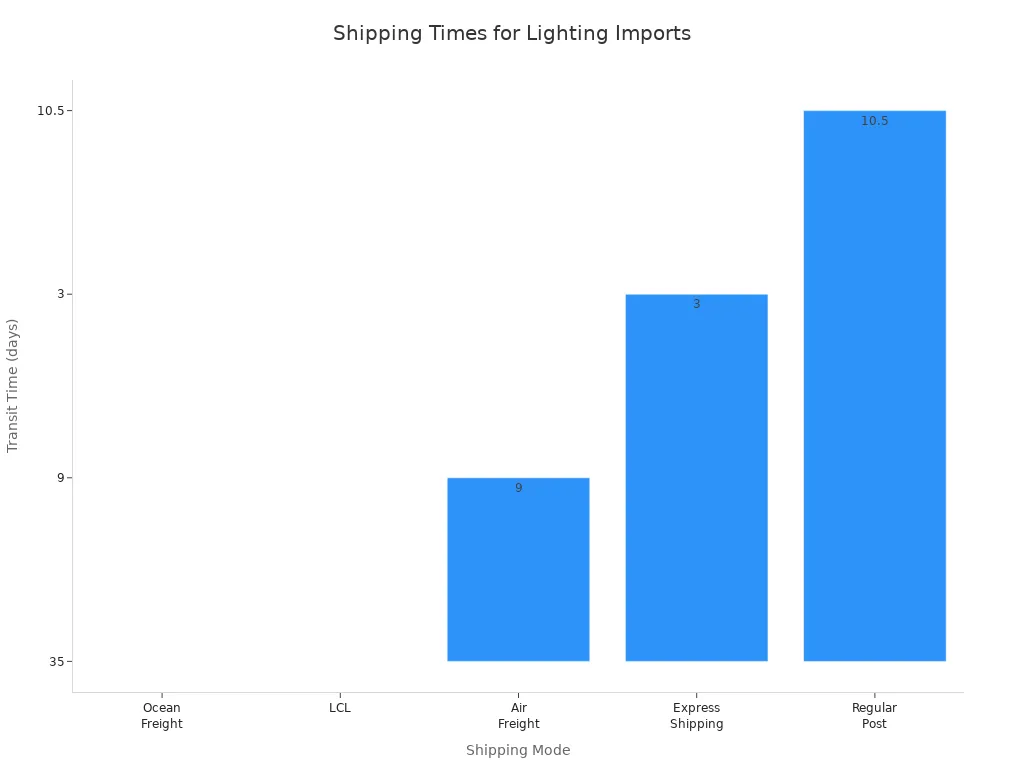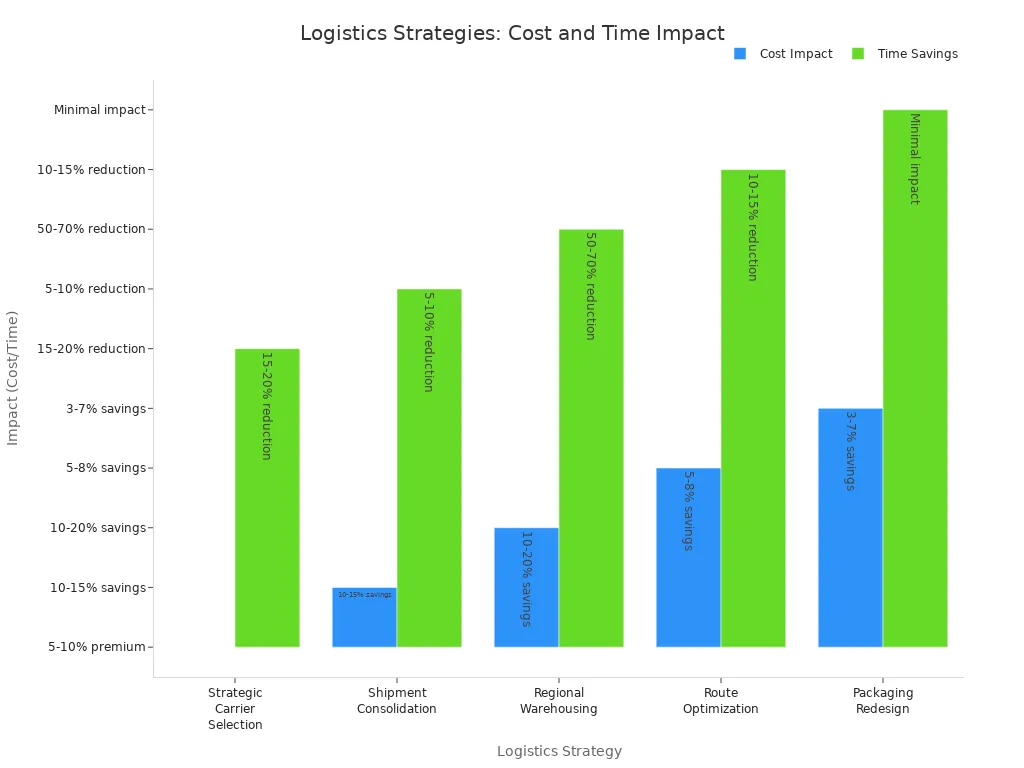Views: 15 Author: Rice Lighting Publish Time: 2025-08-14 Origin: www.ricelighting.com
Importing lighting products from China OEM manufacturers needs good planning and close attention. In 2023, China sent out lamps and light fittings worth about $20.7 billion. The main buyers were the USA, Germany, and the UK. You need to pick trusted suppliers for products like Nordic GU10 Table Reading Light RL-TB073, GU10 Adjustable Flute Cylinder Pendant Light, Multiple GU10 Modern Hanging Pendant Light, 2025 New RGBCW Smart Ceiling Light Ø50cm, and Wood Type LED Ceiling Light. When you import, you will face some problems:
Get all needed papers, like invoices and customs forms.
Make sure products follow RoHS, LVD, and CE standards.
Handle shipping and delivery choices.
Test product samples and check their quality.
Learn about import taxes and customs rules.
Tip: Talk clearly with China OEM suppliers and check certifications early. This helps stop shipment delays or rejections.
Pick trusted China OEM suppliers by looking at their certifications, business licenses, and customer reviews. This helps you avoid delays and problems with quality.
You can save money by buying from China OEM manufacturers. They have lower prices, many lighting products, and can make products for your brand.
Plan your import well by learning about shipping, lead times, payment rules, and import taxes. This helps you avoid surprises and extra costs.
Test product samples and check quality before you order a lot. This makes sure the lighting products are safe and work well.
Keep all needed papers like invoices, certificates, and customs forms ready. This helps you clear customs faster and stops shipment problems.
You can save a lot of money with China OEM lighting. Many companies choose China because it is cheaper. Here are some reasons why:
Lower wages and production costs keep prices down.
Factories are close to raw materials, so shipping is cheaper.
Making lots of products at once means you get discounts.
You do not need to buy costly machines or hire more workers. This helps you use your money better.
Chinese OEM lighting, like LED lights, costs less than in other countries.
Good supply chains and big orders lower costs even more.
Trusted suppliers such as OlamLED give you good prices and quality.
Note: Even after paying for shipping, tariffs, and import fees, China OEM lighting is usually still cheaper than lighting from other places.
China OEM makers have many kinds of lighting products. You can find almost any light you want for your business. The table below lists some main types and examples:
Lighting Category | Examples of Products and Features |
|---|---|
Indoor Lighting | Panel lights, downlights, track lights, and fancy lights for homes and offices |
Outdoor Lighting | Floodlights, street lights, garden lights, and outdoor building lights |
Commercial Lighting | High bay lights, long light systems, and special business lights |
LED Strip & Downlights | Flexible LED strips, light bars, power drivers, and hidden downlights |
Custom OEM/ODM | Custom-made lights, private label, engineering, testing, and help with certifications |
Featured Products | LED Panel Light P2448, Solar Street Light SS200, Industrial High Bay HB500, Flexible LED Strip LS5050, Smart Downlight SD100, Architectural Wall Washer WW300 |
You can also get LED flood lights, tri-proof lights, long lights, neon lights, and stage lights. These choices work for stores, outside areas, and homes.
China OEM makers let you change lighting products in many ways. You can pick the design, finish, logo, box, and even how the light works. For example, Seminglight lets you choose matte, shiny, or metal finishes. You can match colors to your brand and ask for special boxes. Many suppliers let you order small amounts for custom jobs, starting at 300–500 pieces. You can also buy samples, and sometimes get your money back if you order a lot later. Most products follow rules like CE and RoHS. After you buy, you get help like warranties, spare parts, and tech support. This makes it easy to get lighting that fits your brand and market just right.
There are many ways to find China OEM lighting suppliers. Online platforms help you search quickly. You can use Alibaba and 1688 to look for manufacturers. These sites let you compare prices and read reviews. You can also check company profiles. Trade fairs like the Canton Fair and Hong Kong Lighting Fair are helpful too. At these events, you meet suppliers in person. You can see samples and talk about your needs.
You can pick from different supplier types:
Manufacturer Direct: You get good prices and custom choices. They give direct help but need bigger orders and more time.
Wholesale Distributors: You find many products and get fast delivery. You can order less, but there are fewer custom options.
Specialized LED Module Suppliers: These have high-quality parts for business use. They cost more but work very well.
Import/Export Traders: You can order any size and buy from many places. You need to watch quality and shipping closely.
Custom Solution Providers: You get products made just for you. This costs more and takes longer.
Tip: Use Alibaba to compare suppliers and check ratings before you contact them.
Picking the right supplier is very important. Always check if the supplier is trustworthy before you buy. Look for business licenses and export papers. Check for certifications like CE, RoHS, ISO9001, UL, and SAA. These show the supplier follows safety and quality rules.
Here is a checklist for checking China OEM lighting suppliers:
Make sure they have certifications: CE, RoHS, ETL, DLC, ISO9001, UL, Energy Star.
Look at their company history and how long they have worked.
See if their products fit your market.
Check if they allow small orders.
Find out if they do research and make new products.
Ask for test reports like IES files or LM-80.
Read about their warranty and after-sales help.
Think about how fast they deliver and help with shipping.
See if you can change packaging and branding.
Test how well they talk by contacting sales staff.
Read reviews from other customers.
Ask for samples to check product quality.
Note: Always ask for current certification papers and make sure they are real. Good suppliers will show these papers without any problem.
Factory audits help you see what a supplier can really do. You can visit the factory or hire someone to check for you. Auditors look at how products are made and how quality is controlled. They check where materials come from. They also look for branded LED chips and test things like brightness, CRI, and CCT.
A normal audit includes:
Checking if they use real LED chip brands and testing tools.
Looking at heat control materials for outdoor lights.
Reviewing records and labels for raw materials.
Checking the management team and how stable the company is.
These steps help you find problems and make a plan for quality control. Audits make sure your China OEM supplier follows strict rules and gives you good products every time. You feel sure about your orders and avoid expensive mistakes.
Callout: Third-party audits help you see everything clearly and keep your lighting products at a high standard.
When you talk with China OEM lighting manufacturers, do not just think about price. You can get better deals if you order more lights. Buying in big amounts often means you pay less for each one. If you build a good relationship with your supplier, they may trust you more. This can help you get better deals and terms. Always remember, the cheapest price is not always the best. Sometimes, low prices mean the products are not as good.
Know what you need before you start. This means knowing your product details, how many you want, and when you need them.
Sourcing agents can help you talk to suppliers or find good deals.
Look at what the supplier does well and where they are weak. This helps you know how to ask for better deals.
Check what other companies offer. This gives you more power when you talk about price.
Ask for different prices for different order sizes. Try to get better deals, like faster delivery or lower costs.
Pick payment ways that work for you. New buyers can use PayPal. Bigger orders can use bank transfers or letters of credit.
Make sure you understand shipping terms like FOB or EXW. These tell you who pays for shipping and customs.
Ask for a proforma invoice before you finish your order. This helps you check all the details.
Tip: Talk clearly and often about what you want. This helps stop mistakes and saves money.
MOQ means the smallest number you must buy from a factory. Chinese lighting factories set MOQs to help control costs and keep quality good. For simple LED lights, you might only need to buy one. For special lights, like custom chandeliers, you may need to buy at least 100. If you want to buy less, you can sometimes ask for a lower MOQ. You may need to pay more or promise to buy more later. Always ask about MOQ early so you do not get surprised.
You must plan for how long it takes to get your order. Chinese OEM lighting suppliers usually need 2 to 4 weeks to finish your order. This is faster than many other places.
Region | Lead Time Range |
|---|---|
China | 2 to 4 weeks |
Europe | 6 to 8 weeks |
North America | 5 to 7 weeks |
Most suppliers want you to pay 30% first. You pay the other 70% after they make the lights or before they ship them. For big orders, letters of credit can help you with money safety. Many deals use USD so you do not have to worry about changing money.
Always check payment rules and how long your order will take before you buy.
Write down all deals to keep yourself safe.
Note: Give clear product details, talk often, and write down all deals. This helps you get your lights on time and as you want.
You have to check lighting products before importing them. Good manufacturers use strong quality checks for every light. You can ask for samples and test them for brightness and color. You should also check if they are safe. Many factories use special machines to test lights. These machines show how bright the lights are and if they work well.
Here is a table that lists what top manufacturers do for quality:
Manufacturer | Quality Control Measures and Facilities |
|---|---|
Brightlx | 10,000-level dust-free workshop, integrating spheres, photometric testing equipment |
Shenzhen Sunshine Opto-Electronics | Precision molding, surface treatment, anti-UV coatings, scratch resistance |
Wenling Pinsen Machinery | Advanced CNC machining, injection molding, tight tolerances |
Shanghai Muqing Optical | Automated production lines, strict QC protocols |
Shinland Optics | ISO-compliant quality management system |
You should ask for outside inspectors to check your order. They look at products at the start, during, and after making them. Inspectors pick random samples and use AQL standards. This helps you find problems early and keeps your shipment safe.
Tip: Always get inspection reports and test results before you say yes to the shipment. This helps you avoid bad products and returns.
Lighting products must follow important world rules. You need to make sure your supplier meets all safety and green rules. The main certifications are CE, RoHS, and LVD. CE means the product is safe for Europe. RoHS makes sure there are no bad materials like lead. LVD checks if low-voltage devices are safe. Some buyers also want EMC, UL, ETL, SAA, and ISO9001 for other places.
CE marking shows the product follows EU rules.
RoHS makes sure products are safe for the earth.
LVD checks electrical safety.
EMC stops lights from messing with other devices.
UL, ETL, TUV, SAA are needed for North America and other places.
ISO9001 means the factory has good quality control.
You should check these certificates before you order. Many suppliers show their certificates online or send them if you ask. You can also check with official groups to make sure they are real.
Note: If your products do not meet these rules, customs may stop your shipment or charge more fees.
You need the right papers to get your shipment through customs. Each shipment must have invoices, packing lists, certificates of origin, and customs forms. These papers show what you are bringing in, where it is from, and its value.
Here is a list of important papers you need:
Invoices with buyer and seller names, product details, and price.
Packing lists with how many items, their weight, and size.
Certificates of origin to show where the lights were made.
Customs forms with shipment details and how you will use the lights.
You also need copies of all certificates like CE, RoHS, and UL. Customs officers check these papers to make sure your lights are safe and good quality. If you forget any papers, your shipment could be late or turned away.
Callout: Keep all your papers neat and ready to show. Good paperwork helps you get your shipment faster and keeps your business safe.

Shipping Options
There are different ways to ship lighting products from China. Each way has its own speed and price. The table below shows the main choices:
Shipping Method | Delivery Time | Weight Limit | Popular Carriers |
|---|---|---|---|
Rail Freight | 15-35 days | Land-connected only | N/A |
Sea Freight | At least 1 month | No weight limit | N/A |
Express Shipping | 3-7 days | Carrier limits | DHL, DB Schenker, UPS, FedEx |
Sea freight is good for big orders. Express shipping is best for small or urgent orders. Air freight is faster than sea but costs more. You should also learn about Incoterms like FOB, EXW, and CIF. These rules say who pays for shipping, insurance, and customs.

Shipping prices can go up or down during the year. Busy times, like before Chinese New Year, can make shipping slower and more expensive.
Import duties and tariffs make your total cost higher. You need to know your country’s rules. For the United States:
Most lighting products from China have a 30% tariff.
LED lights use HS codes 8539, 8541, and 9405. These have duty rates from 2% to 8%.
Section 301 tariffs can add 7.5% to 25% more, depending on the product.
Flashlights have a 12.5% tariff under HS Code 85131020.
Anti-dumping duties may be added if prices are too low.
Customs fees and VAT also raise your costs. VAT is based on the customs value plus duties.
Using the right HS code helps you avoid fines.
Tip: Always check the newest tariff rates and use the correct HS codes. This helps you avoid costly mistakes.
Importing lighting products can be risky. You can stop many problems by planning ahead. Here are some common risks and how to handle them:
Risk Management Aspect | Recommended Strategy |
|---|---|
Payment Terms | Use safe ways like Letters of Credit or Escrow. Pay in steps. |
Quality Certifications | Check CE, RoHS, UL, ISO 9001. Ask for test reports from other companies. |
Supplier Audits | Visit factories or hire someone to check them for you. |
Sample Testing | Order samples and small shipments before buying a lot. |
Logistics | Work with good freight forwarders. Talk about Incoterms. Make sure packaging is strong. |
Compliance | Follow your country’s rules and get all needed certificates. |
Callout: You lower your risk by checking suppliers, testing products, and using safe payment ways. Always keep records and stay updated on import rules.
Bringing lighting products from China OEM manufacturers takes good planning. You need to pay close attention to every step. Here is how you can do it right:
Look for suppliers at trade shows and trusted websites. Check if they are real and safe to use.
Try out product samples and talk about what you want. Make sure you both agree on the rules.
Watch how the products are made and check their quality. Make sure everything is done well.
Get your shipping ready and fill out all the right papers.
Always learn about new rules and talk often with your suppliers. This helps you avoid big problems and saves money.

You need invoices and packing lists. You also need certificates of origin and customs forms. Always keep CE, RoHS, and UL certificates ready. These papers help you get through customs. They show your products are safe.
Ask for copies of CE, RoHS, and ISO9001 certificates. Check the certificate numbers with official agencies. Good suppliers give you real documents fast.
Most China OEM suppliers ship orders in 2 to 4 weeks. Custom products can take more time. Always check lead times before you order.
Order samples first to check quality. Use safe payment ways like escrow or letters of credit. Hire third-party inspectors for quality checks. Keep records of all deals.
Yes, you must pay import duties and tariffs. The amount depends on your country’s rules. Check the newest rates and HS codes. These fees change your total cost.
